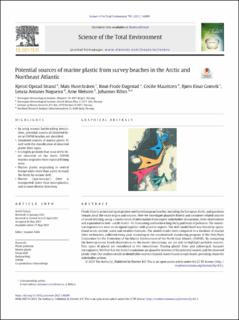Potential sources of marine plastic from survey beaches in the Arctic and Northeast Atlantic
Strand, Kjersti Opstad; Huserbråten, Mats; Dagestad, Knut-Frode; Mauritzen, Cecilie; Grøsvik, Bjørn Einar; Nogueira, Letıcia Antunes; Melsom, Arne; Röhrs, Johannes
Peer reviewed, Journal article
Published version
Date
2021Metadata
Show full item recordCollections
- Articles [3012]
- Publikasjoner fra CRIStin [3070]
Abstract
Plastic litter is accumulating on pristine northern European beaches, including the European Arctic, and questions remain about the exact origins and sources. Here we investigate plausible fishery and consumer-related sources of beach littering, using a combination of information from expert stakeholder discussions, litter observations and a quantitative tool - a drift model - for forecasting and backtracking likely pathways of pollution. The numerical experiments were co-designed together with practice experts. The drift model itself was forced by operational ocean current, wave and weather forecasts. The model results were compared to a database of marine litter on beaches, collected every year according to the standardized monitoring program of the Oslo/Paris Convention for the Protection of the Marine Environment of the North-East Atlantic (OSPAR). By comparing the heterogeneous beach observations to the model simulations, we are able to highlight probable sources. Two types of plastic are considered in the simulations: floating plastic litter and submerged, buoyant microplastics. We find that the model simulations are plausible in terms of the potential sources and the observed plastic litter. Our analysis results in identifiable sources of plastic waste found on each beach, providing a basis for stakeholder actions.
